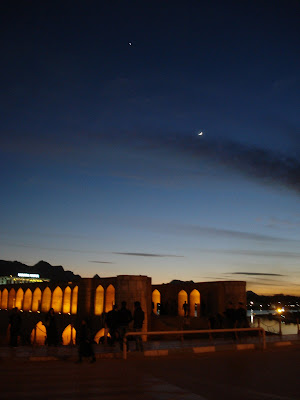New Jolfa
In several postings I have tried to trace the rather good relationship between Iranians and Jews during almost the entire history of ancient Iran. After the Arab conquest of Persia (633-656 CE) Jews were allowed to practice their religion. During Mongolian rule (1256-1318) there were periods of persecution, however. Later, when the Safavids proclaimed Shi’a Islam as the state religion, and in particular during the Qajar dynasty from 1794 onwards, things worsened dramatically. It is sad to say that the European antisemitism found its counterpart in Shi’a-ruled Iran. After the Islamic Revolution in 1979 the majority of Jews left their home country for good. I do not entirely believe that the Persian Jews are directly threatened by the present regime with its hardliner President who consistently uses strong and unacceptable rhetoric with regard to the State of Israel. However, ‘Death to Israel’, 'Death to USA' shouting students on Quds Day (the last Friday in Ramadan) or on every November 4 anniversary of the Iran hostage crisis of 1979 (the picture was taken two years ago in Shiraz) are not really confidence-building. After all Jews are represented in the Majlis by one parliamentarian.


In an unexpected, 180 degrees turn after last Saturday's Geneva talks of 5+1 (members of the UN Security Council and Germany) with Iran’s chief nuclear negotiator Saeed Jalili over Iran’s nuclear program, and the surprising (albeit silent) appearance of US Undersecretary of State William Burns, Iran’s Vice President (in charge of the country’s ailing tourism industry) Esfandiar Rahim Mashaie, a close confidant of the President (his daughter had married Mr. Ahmadinejad’s son last year), described yesterday the US as “one of the best nations in the world.” “Today, Iran is friends with American and Israeli people. No nation in the world is our enemy, this is an honor.” To speak with J. W. von Goethe (Faust I): The message well I hear, my faith alone is weak.
In addition to Jews (~25’000 left) and Zoroastrians (~22’000), a further religious minority in Iran are Christians (~140’000). The Armenian Quarter, New Jolfa, at the southern banks of Esfahan's Zayandeh Rud has been founded under the reign of the Safavid Shah Abbas I in the 17th century. Armenian Christians had been deported to Esfahan by force. Some had fled persecution by the Ottomans. The original Jolfa is, of course, located in Iran’s Azerbaijan province near Tabriz.
New Jolfa is a wonderfully relaxed district with twelve churches, the most important being Vank Cathedral with stunning paintings and gilded carvings all over the interior walls.






Of one religion in Iran I couldn't find any traces, the Bahá’í faith. According to a friend’s remarks, the members of the faith are presently persecuted in Iran similarly as Jews by Germans in Nazi-Deutschland. A particular disgrace and shame for the Iranian authorities, since the Bahá’í Faith was founded in Iran in the 19th century. Even if its very existence presents a challenge to the Islamic doctrine of Muhammad as the seal of all prophets, religious freedom is a universal human right.
I would rather appreciate the tolerance in what is called Medieval times in Persia, say, in Fariduddin Attar’s and Omar Khayyam’s Nishapur a couple of years before the Mongolians conquered the country, when Muslims, Jews and Christians lived in peace and mutual respect and knew the Holy Scripts of each other faith.



Comments